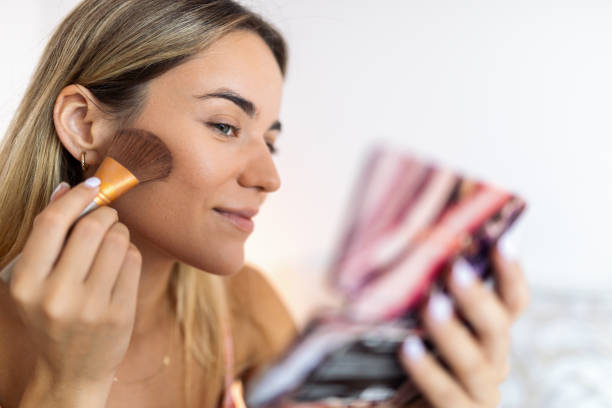Mastering the Art of Contouring: A Step-by-Step Guide to Bronzer Placement
Contouring is a makeup technique that has revolutionized the way we approach highlighting our facial features. By strategically applying bronzer, you can create the illusion of a more sculpted and dimensional face. With the right tools and techniques, bronzer placement can enhance your natural bone structure, define your cheekbones, and even slim the appearance of your face. This article will take you through a comprehensive guide on how to contour your face like a pro, from selecting the right products to mastering bronzer placement for that flawless sculpted look.
Understanding Your Face Shape
Before you start contouring, it’s essential to understand your face shape as this will dictate where you should place your bronzer. Each face shape has different areas that benefit from contouring.
- Oval Face: Lightly contour the sides of your forehead and below your cheekbones to add definition.
- Round Face: Create more angles by contouring the sides of your forehead, underneath your cheekbones, and along your jawline.
- Square Face: Soften your jawline and the angles of your face by contouring the edges of your face and the temples.
- Heart Face: Balance your face by contouring the sides of your forehead to narrow it and below your cheekbones.
- Long Face: Make your face appear shorter by contouring the forehead and the chin area.
Understanding where to place your bronzer in relation to your face shape is crucial for achieving a more natural and defined appearance.
Selecting the Right Tools and Products
You’ll need the right tools and products to contour correctly. A matte bronzer that’s one or two shades darker than your skin tone is ideal as it creates a natural-looking shadow. Opt for bronzers that are free of shimmer to avoid confusion with highlighters, which have a different purpose. A fluffy, angled contour brush is perfect for applying bronzer because it provides more precision and blends the product well, avoiding harsh lines. A makeup sponge can also be useful for blending out the edges and ensuring a seamless finish.
Some popular products ideal for contouring include:
- Kat Von D Shade + Light Contour Palette
- Benefit Cosmetics Hoola Matte Bronzer
- NYX Professional Makeup Matte Bronzer
- Too Faced Chocolate Soleil Matte Bronzer
Always remember to select a bronzer that complements your undertone to keep it looking natural. For the brush, cleanliness is key for the best application, so regularly wash your tools to maintain their performance.

Brushing Up on Technique: Bronzer Placement
After selecting the optimal tools and bronzer, follow these guidelines to strategically apply your bronzer for a sculpted effect:
- Prepare Your Skin: Start with a clean, moisturized face. Apply your foundation and concealer as you normally would.
- Map Your Face: Using the angled brush, lightly trace the natural shadows of your face. This includes under your cheekbones, along your jawline, on the temples, and along the sides of your nose.
- Light Touch: Use a light hand to build up the product gradually. It’s easier to add more bronzer than to remove excess.
- Blending is Key: Make sure to blend thoroughly for a natural look. Harsh lines will make your contour appear artificial.
- Balance with Blush and Highlighter: Complement your contour with a touch of blush on the apples of your cheeks and a highlighter on the high points of your face for a full, balanced look.
Always adapt the intensity of your contour to the occasion. Subtle application is suitable for daytime, while a more dramatic contour can be appropriate for evening events.
Advanced Tips and Tricks
For those who want to take their contouring skills to the next level, here are some advanced tips:
- Contouring the Nose: To slim the nose, draw two lines from the beginning of your brows down to the sides of your nose and blend. Remember, this step requires a delicate touch.
- Adjusting to Lighting: Natural light is the best to apply makeup under, as it reveals true colors and helps prevent over-application.
- Color Correction: If you have redness or sallowness, you can use a color-correcting concealer before contouring to achieve an even base.
- Layering Techniques: Layer creams under powders for a long-lasting contour. Be sure to blend each layer before applying the next.
- Powder Setting: After you have contoured, set everything with a translucent powder to lock the makeup in place and mattify your skin.
Remember, practice makes perfect, and these advanced techniques can help you tailor your contour to perfection.
Conclusion
Contouring is an invaluable makeup technique that can dramatically enhance your facial features. By understanding your face shape, choosing the right tools and products, and mastering the art of bronzer placement, you can achieve a beautifully sculpted look. It’s essential to select bronzers that suit your skin tone, apply them with precision, and blend thoroughly. With these tips and tricks, anyone can create defined and natural-looking contours that complement their unique beauty. As with any skill, practice leads to improvement, so experiment, find what works best for you, and embrace the transformative power of contouring.
FAQs
- Can contouring look natural on a daily basis? Absolutely. For a natural look, use a light hand with a matte bronzer and blend thoroughly. The key is to enhance your features subtly.
- Is it necessary to use a special contouring brush? While not necessary, a contouring brush can provide more control and precision with application, ensuring a more polished result.
- How do I find the right bronzer shade? Choose a matte bronzer one or two shades darker than your skin tone. If you have cool undertones, look for a bronzer with a cooler, grayish undertone. For warm undertones, a warmer, earthy bronzer is more fitting.
- Can I contour with cream and powder products? Yes, you can layer cream products underneath powder for a more dimensional and long-lasting contour. Just ensure you blend each layer before applying the next.
- How can I fix contouring mistakes? If you’ve applied too much product, blend it out with a clean brush or sponge and balance it by applying a little more foundation or translucent powder over the top.



